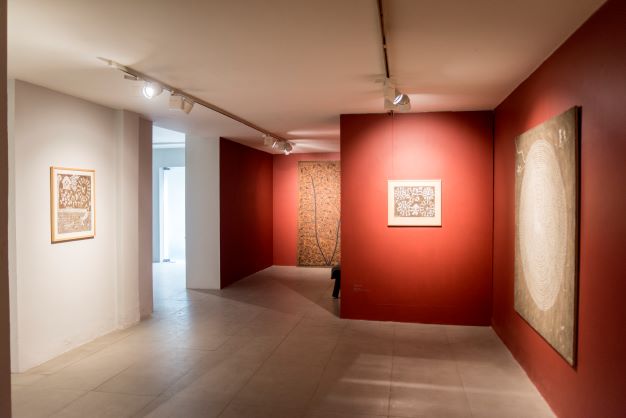
GIVEN POWER FROM TRADITION TO CONTEMPORARY
GIVEN POWER: FROM TRADITION TO CONTEMPORARY
Yanage in his book “The Unknown craftsmen” has attributed the beauty of an object to a craftsman give power, or his ability to adhere or to submissively rely to one’s tradition. He mentions that’s any craftsman, who is strong in his tradition and with the accumulation of experience and wisdom of many generations would be able to create works of art
that are beyond the self. It is in this generational trance that the artist has the ability to create freely and without bound and in the process losing the site of individualism today.
This show presents a selection of works collected from the interiors of Madhya Pradesh, West Bengal, Bihar and Maharashtra. The work offers an invitation to the reader to discover other regions, other styles, and other artists that epitomize the incomparable diversity of the contemporary tribal and popular Indian art.
The Bhils are an indigenous tribal community found in the western Deccan regions and central India among other smaller clusters in the sub-continent. Essentially a farming community, their art draws from nature-based themes and the animal kingdom. Changing seasons, natural phenomena and gods that protect them are common subjects. The natural colours are vibrant and locally prepared. The ritualistic art is practiced in daily life as on special occasions, most popularly in decorating the walls of their domestic spaces. Pit hora paintings are one of their traditional art forms that has garnered attention in the recent years. Paintings on walls as an offering to the Goddesses are made annually and are the focal point of Bhil art.
The Gonds are one of the largest indigenous communities of India, concentrated in Madhya Pradesh and the surrounding regions. The word gond comes from kond, a dravidian word meaning green mountains. Traditional gond art was created on the walls and facades of their domestic and community spaces. It is in the early 1980s that a cluster of Gond artist starting adapting their ritualistic painting to modern mediums likes paper and canvases. Modern gond art demonstrates strong roots in their historic lifestyle, natural world, mythological beliefs and songs and oral histories. These complex and intriguing aspects merge aesthetically with modern modes of depiction and techniques, resulting in colorful odes to their myriad past.
Given Power From Tradition to Contemporary, Display View
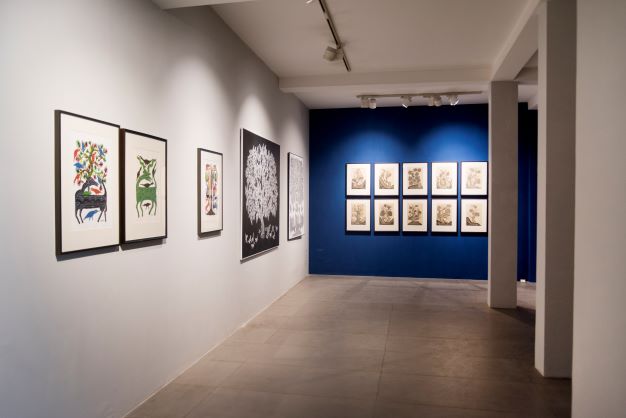
GIVEN POWER FROM TRADITION TO CONTEMPORARY
GIVEN POWER: FROM TRADITION TO CONTEMPORARY
Yanage in his book “The Unknown craftsmen” has attributed the beauty of an object to a craftsman give power, or his ability to adhere or to submissively rely to one’s tradition. He mentions that’s any craftsman, who is strong in his tradition and with the accumulation of experience and wisdom of many generations would be able to create works of art
that are beyond the self. It is in this generational trance that the artist has the ability to create freely and without bound and in the process losing the site of individualism today.
This show presents a selection of works collected from the interiors of Madhya Pradesh, West Bengal, Bihar and Maharashtra. The work offers an invitation to the reader to discover other regions, other styles, and other artists that epitomize the incomparable diversity of the contemporary tribal and popular Indian art.
The Bhils are an indigenous tribal community found in the western Deccan regions and central India among other smaller clusters in the sub-continent. Essentially a farming community, their art draws from nature-based themes and the animal kingdom. Changing seasons, natural phenomena and gods that protect them are common subjects. The natural colours are vibrant and locally prepared. The ritualistic art is practiced in daily life as on special occasions, most popularly in decorating the walls of their domestic spaces. Pit hora paintings are one of their traditional art forms that has garnered attention in the recent years. Paintings on walls as an offering to the Goddesses are made annually and are the focal point of Bhil art.
The Gonds are one of the largest indigenous communities of India, concentrated in Madhya Pradesh and the surrounding regions. The word gond comes from kond, a dravidian word meaning green mountains. Traditional gond art was created on the walls and facades of their domestic and community spaces. It is in the early 1980s that a cluster of Gond artist starting adapting their ritualistic painting to modern mediums likes paper and canvases. Modern gond art demonstrates strong roots in their historic lifestyle, natural world, mythological beliefs and songs and oral histories. These complex and intriguing aspects merge aesthetically with modern modes of depiction and techniques, resulting in colorful odes to their myriad past.
Given Power From Tradition to Contemporary, Display View
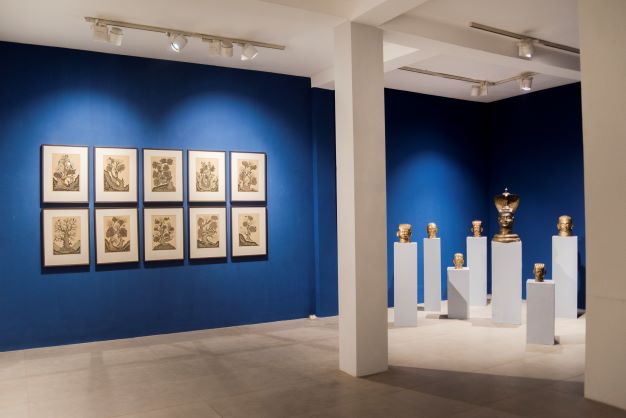
GIVEN POWER FROM TRADITION TO CONTEMPORARY
GIVEN POWER: FROM TRADITION TO CONTEMPORARY
Yanage in his book “The Unknown craftsmen” has attributed the beauty of an object to a craftsman give power, or his ability to adhere or to submissively rely to one’s tradition. He mentions that’s any craftsman, who is strong in his tradition and with the accumulation of experience and wisdom of many generations would be able to create works of art
that are beyond the self. It is in this generational trance that the artist has the ability to create freely and without bound and in the process losing the site of individualism today.
This show presents a selection of works collected from the interiors of Madhya Pradesh, West Bengal, Bihar and Maharashtra. The work offers an invitation to the reader to discover other regions, other styles, and other artists that epitomize the incomparable diversity of the contemporary tribal and popular Indian art.
The Bhils are an indigenous tribal community found in the western Deccan regions and central India among other smaller clusters in the sub-continent. Essentially a farming community, their art draws from nature-based themes and the animal kingdom. Changing seasons, natural phenomena and gods that protect them are common subjects. The natural colours are vibrant and locally prepared. The ritualistic art is practiced in daily life as on special occasions, most popularly in decorating the walls of their domestic spaces. Pit hora paintings are one of their traditional art forms that has garnered attention in the recent years. Paintings on walls as an offering to the Goddesses are made annually and are the focal point of Bhil art.
The Gonds are one of the largest indigenous communities of India, concentrated in Madhya Pradesh and the surrounding regions. The word gond comes from kond, a dravidian word meaning green mountains. Traditional gond art was created on the walls and facades of their domestic and community spaces. It is in the early 1980s that a cluster of Gond artist starting adapting their ritualistic painting to modern mediums likes paper and canvases. Modern gond art demonstrates strong roots in their historic lifestyle, natural world, mythological beliefs and songs and oral histories. These complex and intriguing aspects merge aesthetically with modern modes of depiction and techniques, resulting in colorful odes to their myriad past.
Given Power From Tradition to Contemporary, Display View
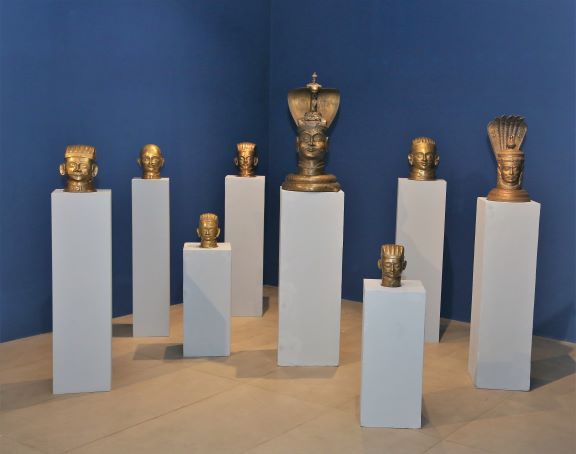
GIVEN POWER FROM TRADITION TO CONTEMPORARY
GIVEN POWER: FROM TRADITION TO CONTEMPORARY
Yanage in his book “The Unknown craftsmen” has attributed the beauty of an object to a craftsman give power, or his ability to adhere or to submissively rely to one’s tradition. He mentions that’s any craftsman, who is strong in his tradition and with the accumulation of experience and wisdom of many generations would be able to create works of art
that are beyond the self. It is in this generational trance that the artist has the ability to create freely and without bound and in the process losing the site of individualism today.
This show presents a selection of works collected from the interiors of Madhya Pradesh, West Bengal, Bihar and Maharashtra. The work offers an invitation to the reader to discover other regions, other styles, and other artists that epitomize the incomparable diversity of the contemporary tribal and popular Indian art.
The Bhils are an indigenous tribal community found in the western Deccan regions and central India among other smaller clusters in the sub-continent. Essentially a farming community, their art draws from nature-based themes and the animal kingdom. Changing seasons, natural phenomena and gods that protect them are common subjects. The natural colours are vibrant and locally prepared. The ritualistic art is practiced in daily life as on special occasions, most popularly in decorating the walls of their domestic spaces. Pit hora paintings are one of their traditional art forms that has garnered attention in the recent years. Paintings on walls as an offering to the Goddesses are made annually and are the focal point of Bhil art.
The Gonds are one of the largest indigenous communities of India, concentrated in Madhya Pradesh and the surrounding regions. The word gond comes from kond, a dravidian word meaning green mountains. Traditional gond art was created on the walls and facades of their domestic and community spaces. It is in the early 1980s that a cluster of Gond artist starting adapting their ritualistic painting to modern mediums likes paper and canvases. Modern gond art demonstrates strong roots in their historic lifestyle, natural world, mythological beliefs and songs and oral histories. These complex and intriguing aspects merge aesthetically with modern modes of depiction and techniques, resulting in colorful odes to their myriad past.
Given Power From Tradition to Contemporary, Display View
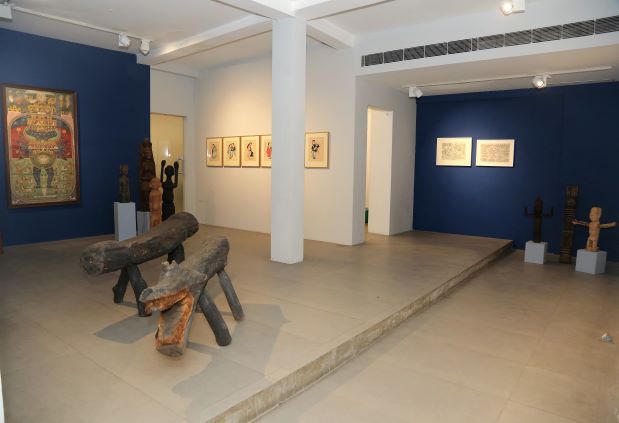
GIVEN POWER FROM TRADITION TO CONTEMPORARY
GIVEN POWER: FROM TRADITION TO CONTEMPORARY
Yanage in his book “The Unknown craftsmen” has attributed the beauty of an object to a craftsman give power, or his ability to adhere or to submissively rely to one’s tradition. He mentions that’s any craftsman, who is strong in his tradition and with the accumulation of experience and wisdom of many generations would be able to create works of art
that are beyond the self. It is in this generational trance that the artist has the ability to create freely and without bound and in the process losing the site of individualism today.
This show presents a selection of works collected from the interiors of Madhya Pradesh, West Bengal, Bihar and Maharashtra. The work offers an invitation to the reader to discover other regions, other styles, and other artists that epitomize the incomparable diversity of the contemporary tribal and popular Indian art.
The Bhils are an indigenous tribal community found in the western Deccan regions and central India among other smaller clusters in the sub-continent. Essentially a farming community, their art draws from nature-based themes and the animal kingdom. Changing seasons, natural phenomena and gods that protect them are common subjects. The natural colours are vibrant and locally prepared. The ritualistic art is practiced in daily life as on special occasions, most popularly in decorating the walls of their domestic spaces. Pit hora paintings are one of their traditional art forms that has garnered attention in the recent years. Paintings on walls as an offering to the Goddesses are made annually and are the focal point of Bhil art.
The Gonds are one of the largest indigenous communities of India, concentrated in Madhya Pradesh and the surrounding regions. The word gond comes from kond, a dravidian word meaning green mountains. Traditional gond art was created on the walls and facades of their domestic and community spaces. It is in the early 1980s that a cluster of Gond artist starting adapting their ritualistic painting to modern mediums likes paper and canvases. Modern gond art demonstrates strong roots in their historic lifestyle, natural world, mythological beliefs and songs and oral histories. These complex and intriguing aspects merge aesthetically with modern modes of depiction and techniques, resulting in colorful odes to their myriad past.
Given Power From Tradition to Contemporary, Display View
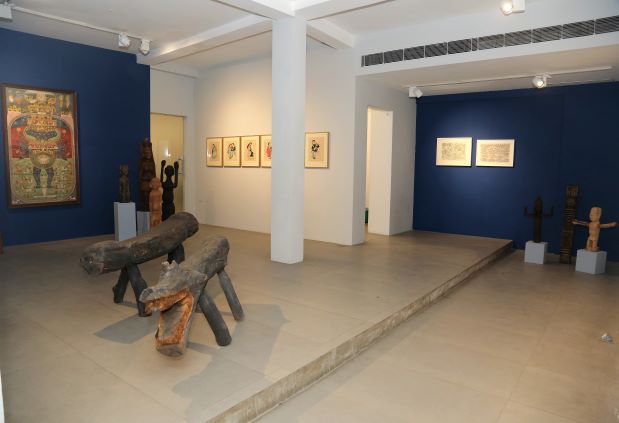
GIVEN POWER FROM TRADITION TO CONTEMPORARY
GIVEN POWER: FROM TRADITION TO CONTEMPORARY
Yanage in his book “The Unknown craftsmen” has attributed the beauty of an object to a craftsman give power, or his ability to adhere or to submissively rely to one’s tradition. He mentions that’s any craftsman, who is strong in his tradition and with the accumulation of experience and wisdom of many generations would be able to create works of art
that are beyond the self. It is in this generational trance that the artist has the ability to create freely and without bound and in the process losing the site of individualism today.
This show presents a selection of works collected from the interiors of Madhya Pradesh, West Bengal, Bihar and Maharashtra. The work offers an invitation to the reader to discover other regions, other styles, and other artists that epitomize the incomparable diversity of the contemporary tribal and popular Indian art.
The Bhils are an indigenous tribal community found in the western Deccan regions and central India among other smaller clusters in the sub-continent. Essentially a farming community, their art draws from nature-based themes and the animal kingdom. Changing seasons, natural phenomena and gods that protect them are common subjects. The natural colours are vibrant and locally prepared. The ritualistic art is practiced in daily life as on special occasions, most popularly in decorating the walls of their domestic spaces. Pit hora paintings are one of their traditional art forms that has garnered attention in the recent years. Paintings on walls as an offering to the Goddesses are made annually and are the focal point of Bhil art.
The Gonds are one of the largest indigenous communities of India, concentrated in Madhya Pradesh and the surrounding regions. The word gond comes from kond, a dravidian word meaning green mountains. Traditional gond art was created on the walls and facades of their domestic and community spaces. It is in the early 1980s that a cluster of Gond artist starting adapting their ritualistic painting to modern mediums likes paper and canvases. Modern gond art demonstrates strong roots in their historic lifestyle, natural world, mythological beliefs and songs and oral histories. These complex and intriguing aspects merge aesthetically with modern modes of depiction and techniques, resulting in colorful odes to their myriad past.
Given Power From Tradition to Contemporary
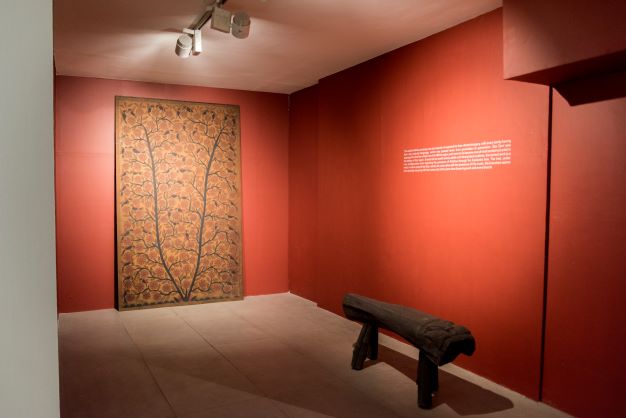
GIVEN POWER FROM TRADITION TO CONTEMPORARY
GIVEN POWER: FROM TRADITION TO CONTEMPORARY
Yanage in his book “The Unknown craftsmen” has attributed the beauty of an object to a craftsman give power, or his ability to adhere or to submissively rely to one’s tradition. He mentions that’s any craftsman, who is strong in his tradition and with the accumulation of experience and wisdom of many generations would be able to create works of art
that are beyond the self. It is in this generational trance that the artist has the ability to create freely and without bound and in the process losing the site of individualism today.
This show presents a selection of works collected from the interiors of Madhya Pradesh, West Bengal, Bihar and Maharashtra. The work offers an invitation to the reader to discover other regions, other styles, and other artists that epitomize the incomparable diversity of the contemporary tribal and popular Indian art.
The Bhils are an indigenous tribal community found in the western Deccan regions and central India among other smaller clusters in the sub-continent. Essentially a farming community, their art draws from nature-based themes and the animal kingdom. Changing seasons, natural phenomena and gods that protect them are common subjects. The natural colours are vibrant and locally prepared. The ritualistic art is practiced in daily life as on special occasions, most popularly in decorating the walls of their domestic spaces. Pit hora paintings are one of their traditional art forms that has garnered attention in the recent years. Paintings on walls as an offering to the Goddesses are made annually and are the focal point of Bhil art.
The Gonds are one of the largest indigenous communities of India, concentrated in Madhya Pradesh and the surrounding regions. The word gond comes from kond, a dravidian word meaning green mountains. Traditional gond art was created on the walls and facades of their domestic and community spaces. It is in the early 1980s that a cluster of Gond artist starting adapting their ritualistic painting to modern mediums likes paper and canvases. Modern gond art demonstrates strong roots in their historic lifestyle, natural world, mythological beliefs and songs and oral histories. These complex and intriguing aspects merge aesthetically with modern modes of depiction and techniques, resulting in colorful odes to their myriad past.
Given Power From Tradition to Contemporary, Display View
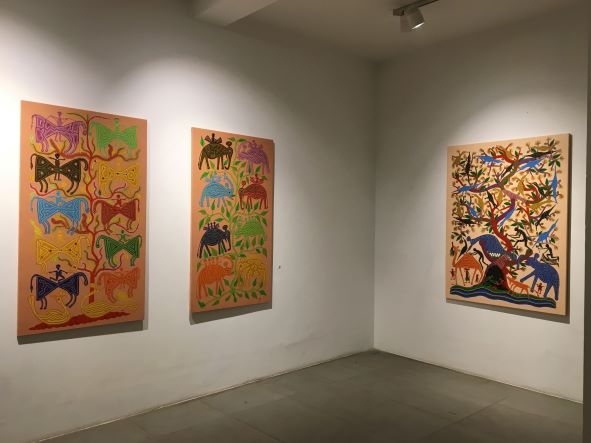
GIVEN POWER FROM TRADITION TO CONTEMPORARY
GIVEN POWER: FROM TRADITION TO CONTEMPORARY
Yanage in his book “The Unknown craftsmen” has attributed the beauty of an object to a craftsman give power, or his ability to adhere or to submissively rely to one’s tradition. He mentions that’s any craftsman, who is strong in his tradition and with the accumulation of experience and wisdom of many generations would be able to create works of art
that are beyond the self. It is in this generational trance that the artist has the ability to create freely and without bound and in the process losing the site of individualism today.
This show presents a selection of works collected from the interiors of Madhya Pradesh, West Bengal, Bihar and Maharashtra. The work offers an invitation to the reader to discover other regions, other styles, and other artists that epitomize the incomparable diversity of the contemporary tribal and popular Indian art.
The Bhils are an indigenous tribal community found in the western Deccan regions and central India among other smaller clusters in the sub-continent. Essentially a farming community, their art draws from nature-based themes and the animal kingdom. Changing seasons, natural phenomena and gods that protect them are common subjects. The natural colours are vibrant and locally prepared. The ritualistic art is practiced in daily life as on special occasions, most popularly in decorating the walls of their domestic spaces. Pit hora paintings are one of their traditional art forms that has garnered attention in the recent years. Paintings on walls as an offering to the Goddesses are made annually and are the focal point of Bhil art.
The Gonds are one of the largest indigenous communities of India, concentrated in Madhya Pradesh and the surrounding regions. The word gond comes from kond, a dravidian word meaning green mountains. Traditional gond art was created on the walls and facades of their domestic and community spaces. It is in the early 1980s that a cluster of Gond artist starting adapting their ritualistic painting to modern mediums likes paper and canvases. Modern gond art demonstrates strong roots in their historic lifestyle, natural world, mythological beliefs and songs and oral histories. These complex and intriguing aspects merge aesthetically with modern modes of depiction and techniques, resulting in colorful odes to their myriad past.
Given Power From Tradition to Contemporary, Display View
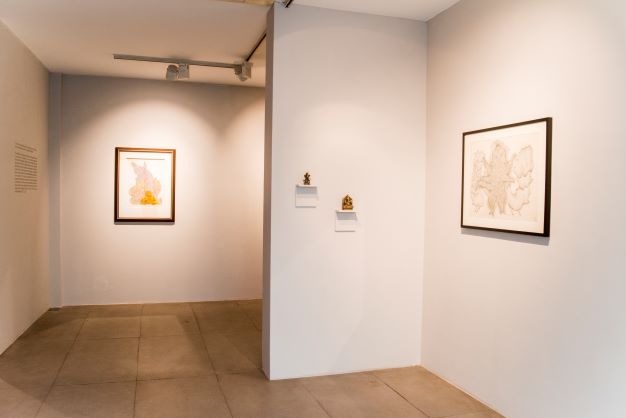
GIVEN POWER FROM TRADITION TO CONTEMPORARY
GIVEN POWER: FROM TRADITION TO CONTEMPORARY
Yanage in his book “The Unknown craftsmen” has attributed the beauty of an object to a craftsman give power, or his ability to adhere or to submissively rely to one’s tradition. He mentions that’s any craftsman, who is strong in his tradition and with the accumulation of experience and wisdom of many generations would be able to create works of art
that are beyond the self. It is in this generational trance that the artist has the ability to create freely and without bound and in the process losing the site of individualism today.
This show presents a selection of works collected from the interiors of Madhya Pradesh, West Bengal, Bihar and Maharashtra. The work offers an invitation to the reader to discover other regions, other styles, and other artists that epitomize the incomparable diversity of the contemporary tribal and popular Indian art.
The Bhils are an indigenous tribal community found in the western Deccan regions and central India among other smaller clusters in the sub-continent. Essentially a farming community, their art draws from nature-based themes and the animal kingdom. Changing seasons, natural phenomena and gods that protect them are common subjects. The natural colours are vibrant and locally prepared. The ritualistic art is practiced in daily life as on special occasions, most popularly in decorating the walls of their domestic spaces. Pit hora paintings are one of their traditional art forms that has garnered attention in the recent years. Paintings on walls as an offering to the Goddesses are made annually and are the focal point of Bhil art.
The Gonds are one of the largest indigenous communities of India, concentrated in Madhya Pradesh and the surrounding regions. The word gond comes from kond, a dravidian word meaning green mountains. Traditional gond art was created on the walls and facades of their domestic and community spaces. It is in the early 1980s that a cluster of Gond artist starting adapting their ritualistic painting to modern mediums likes paper and canvases. Modern gond art demonstrates strong roots in their historic lifestyle, natural world, mythological beliefs and songs and oral histories. These complex and intriguing aspects merge aesthetically with modern modes of depiction and techniques, resulting in colorful odes to their myriad past.
Given Power From Tradition to Contemporary, Display View

